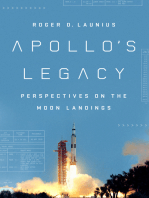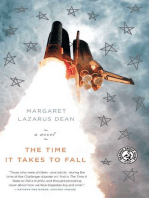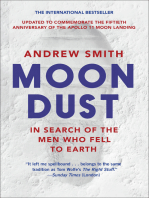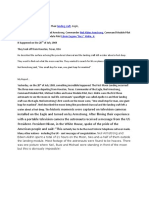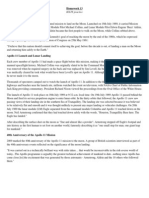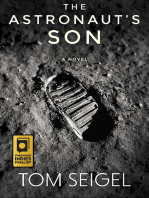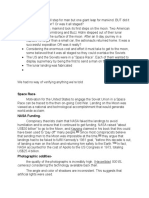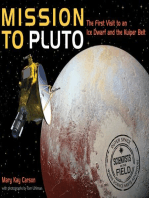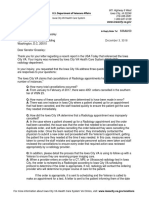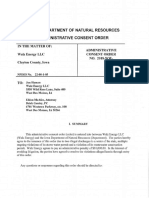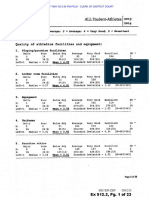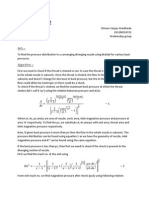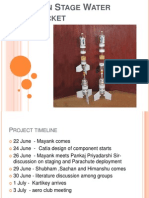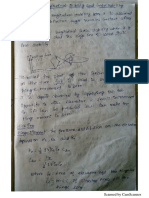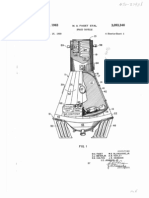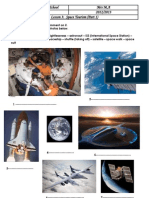Neil Armstrong, Collins Connection 1994-06-27
Neil Armstrong, Collins Connection 1994-06-27
Uploaded by
The GazetteCopyright:
Available Formats
Neil Armstrong, Collins Connection 1994-06-27
Neil Armstrong, Collins Connection 1994-06-27
Uploaded by
The GazetteCopyright
Available Formats
Share this document
Did you find this document useful?
Is this content inappropriate?
Copyright:
Available Formats
Neil Armstrong, Collins Connection 1994-06-27
Neil Armstrong, Collins Connection 1994-06-27
Uploaded by
The GazetteCopyright:
Available Formats
INSIDE
Comics, 3C TV, Abby,4C
HEALTH &
c
Responsible for astronauts' lives
Editor's Note: The follow ing was written by Jim Westcot and was part of his 1989 memoir, "To the Moon in a Volkswagen."
Apollo took man to moon
C.R., Collins had big role 25 years ago
By Tom Walsh
e was just a grade school kid in Kansas, sprawled one beautiful summer evening on his front lawn, staring into the night sky. "I remember this other kid asking me, 'Do you think we will ever get to the moon?' " Dick Rowland recalls now, more than 50 years later. "I said, 'Of course we will, but never in my lifetime.'" Rowland, 64, couldn't know it then, but as an electrical engineer at Collins Radio Company in Cedar Rapids, he'd later spend 10 years on the front lines of the U.S. space program, in the thick of the frantic effort to put an astronaut on the moon. At 9:56 p.m. on July 20,1969, when Neil Armstrong stepped down from the lunar lander and pronounced he had taken "One small step for man . . . One giant leap for mankind," his words were beamed to Earth on a radio system Rowland and hundreds of other Collins workers had spent years perfecting for the Apollo moon mission. Now retired after 33 years as an avionics systems engineer and living in Cedar Rapids at 2508 Blue Ridge Dr. NE, Rowland will join hundreds of other Apollo-era colleagues for a July 20 reunion and celebration of the 25th anniversary of man's first moon walk. During its peak in the mid-1960s, the Apollo program involved more than 500 Collins workers. As a subcontractor for North American Aviation, Collins was recruited to provide all the communications and data electronics for the Apollo command module and all voice and data transmission equipment needed to link the Apollo astronauts with Earth. "Neil Armstrong and the others couldn't talk back and forth without going through some Collins equipment," Rowland says. "That was true in the U.S. space program from Mercury through Apollo." Now 67 and living at 3815 Indiandale Circle SE, Jim Westcot was the Apollo program manager at Collins. He says he'll never forget the night Armstrong left his bootprints in the lunar dust. "I was out on my deck, in Cedar Rapids, with my wife, Helen, and our three daughters," he recalls. "We had brought out a little TV set, and. we were looking both at it and this nearly full moon above us. It was absolutely thrilling. It just made the hair stand up on the back of my neck." Westcot remembers how the intensity of the effort invested in Apollo was hard on his family all those years of late night and road trips, being away for holidays and birthdays. "It was an exciting time, but we worked our tails off," he says. "There hasn't been a program before or since that had the quality and prevention built into it as did Apollo." Westcot and Rowland say state-of-the-art communications
Gazette Correspondent
During the course of the Apollo program we had many of the astronauts vis it us to keep us excited about the program and keep our spirits high. At one time or another, I be lieve that almost all of them visited Cedar Rapids. One visit, however, had unexpected results. It was unusual for the astronauts to visit the fac tory floor where the equip ment was being assembled, mostly by women workers. After an especially rousing speech, a unique event took place. A few of the people working on the pro gram asked to be trans ferred, and some actually quit. The problem was that they didn't want any part of being responsible for the lives of the astronauts dur ing the space missions. I guess the speeches were a little too effective.
Edwin Aldrin, pilot, is shown on the moon near Apollo 1 1 . The photo was taken by Neil Armstrong, the Apollo commander.
NASA photo
Gazette photos by Todd Mclnturf
AT LEFT: Retired Rockwell Collins employees Dick Rowland (standing)
and Jim Westcot, both of Cedar Rapids, pose next to an Apollo exhibit at Rockwell Collins. Both men worked on the Apollo communications program. ABOVE: Receivers and transmitters used for communications in the Apollo spacecraft. This equipment is part of 10 pieces used.
equipment wasn't used for Apollo. "The NASA (National Aeronautics and Space Administration) program manager, Joe Shea, would say, 'I want to go to the moon in a Volkswagen,' which meant the design emphasis was on reliability, not high-tech. We
absolutely had to be sure there wasn't a failure, and there wasn't. One of our units had quad redundancy, which meant, after three failures, it. would still work." Turn to 2C: Apollo
Space lessons for area youngsters
Art Collins 'just whooped' at 1st view
By Dale Kueter
Gazette staff writer
pace travel and research will be the focus of activities and exhibits planned this summer by the Science Station, 427 First St. SE. A series of events for the week of July 17 planned jointly with Rockwell Collins and the Cedar Rapids Public Libary will note the anniversary of Neil Armstrong's walk on the moon July 20,1969. Events are as follows: Freedom Festival Star Lab, June 28 to July 4, Science Station. A miniature planetarium show will be held Tuesday through Saturday each hour beginning at 10 a.m. and Sunday and Monday each hour beginning at 1 p.m. Exhibit: "Space: All Things Imagined are Real," July 5 to Aug. 21, Science Station. Exhibit is from Melbourne, Florida's Space Coast Science Center in cooperation with NASA, Lockheed and Rockwell. Program: "You Don't Have to be a Rocket Scientist To Appreciate Space," July 19 from 7 to 9 p.m., Beems Auditorium, Public Library, featuring Donald Gurnett of the University of Iowa, and Steven Feller of Coe College, both physicists. Space Olympics, Science Station, July 20,10 a.m. to 4 p.m. Contests for all ages. Free to members. Cost for non-members: $2 for children 2-18; $3 for adults; $2.50 for senior citizens over 62. "Collision with Jupiter," "July 21, 9 a.m., program and live viewing, Science Station. Lunar Mission for Preschoolers, ages 3 to 6, July 24, Science Station. Instructor will be Helen Salvay. Advanced registration is required. Member cost, $3; non-member cost, $5.
ike many other families, Arthur and Mary Collins, and their two young sons, Allen and David, had their eyes fixed on the TV set, watching history in the making from their Cedar Rapids home. Then Neil Armstrong took a couple of steps on the moon and spoke. "I can still remember how clear the pictures and voice (communications) were," said Mary Collins. "And he just whooped." Art Collins, the reserved founder of Collins Radio Co., whose equipment transmitted the Apollo 11 video and audio story around the world, whooped. "The kids didn't know what he was whooping about, but they whooped, too. We sat there like silly, grinning Cheshire cats," she said. Then, like many other families, they went outside and looked at the moon, a nearly full moon. It still looked the same, but it wasn't. Art Collins, once a boy inventor and 59 in 1969, had once again thrust his name and that of his company into the history books just as he did in 1928
am excited like everyone. It was just fantastic, a great tribute to the people of Cedar Rapids who played a part in making this possible.
99
Art Collins
and 1929 when his radios linked America with the South Pole adventures of Adm. Richard E. Byrd. "Those were exciting times," Mary Collins recalled recently from her Dallas home, where she moved several years ago after selling the family home in southeast Cedar Rapids. Arthur Collins died in 1987. "Somehow," she said in a
telephone interview, "while today's innovations are wonderful they don't seem as adventurous, as exciting as the moon walks. "It was a great thing. You sat there and wondered if it was going to work. Previous missions indicated it would. Yet, landing on the moon is different than just traveling in space." The next day Collins flew to
Dallas where he watched the remainder of the high drama. There, with the help of Mary Collins, The Gazette obtained a rare interview with Collins. "I am excited like everyone. It was just fantastic," he said, "a great tribute to the people of Cedar Rapids who played a part in making this possible. It was the people who did it," he repeated. "One of the things you think about is the feeling of accomplishment and personal participation. Everyone in Cedar Rapids certainly should be overjoyed." While all of the contractors and sub-contractors had gone on national television to outline their roles in the Apollo program, Collins didn't. It has always been sort of a mystery, but it was really quite simple, said Mary Collins. "He was not a publicity seeker," she said, recalling when he turned down an interview with Walter Cronkite. "He was shy. He knew he had to do certain things, like conduct the annual meetings and talk to engineering groups. But he was
Turn to 2C:
Collins
You might also like
- 690A B Training ManualDocument336 pages690A B Training ManualAviacion Jlp100% (12)
- One Giant Leap: The Impossible Mission That Flew Us to the MoonFrom EverandOne Giant Leap: The Impossible Mission That Flew Us to the MoonRating: 4.5 out of 5 stars4.5/5 (44)
- Team Moon: How 400,000 People Landed Apollo 11 on the MoonFrom EverandTeam Moon: How 400,000 People Landed Apollo 11 on the MoonRating: 4 out of 5 stars4/5 (87)
- Moon Shot: The Inside Story of America's Apollo Moon LandingsFrom EverandMoon Shot: The Inside Story of America's Apollo Moon LandingsRating: 3.5 out of 5 stars3.5/5 (15)
- Bond Shymansky University of Iowa ContractDocument25 pagesBond Shymansky University of Iowa ContractThe GazetteNo ratings yet
- V Speeds UnavailableDocument2 pagesV Speeds UnavailableFikre DessalegnNo ratings yet
- Gliderdesignresearch Phase1Document2 pagesGliderdesignresearch Phase1api-318159835100% (1)
- The Apollo Missions for Kids: The People and Engineering Behind the Race to the Moon, with 21 ActivitiesFrom EverandThe Apollo Missions for Kids: The People and Engineering Behind the Race to the Moon, with 21 ActivitiesRating: 5 out of 5 stars5/5 (2)
- American Moonshot: John F. Kennedy and the Great Space RaceFrom EverandAmerican Moonshot: John F. Kennedy and the Great Space RaceRating: 4 out of 5 stars4/5 (51)
- Booklet 2024 - With NumbersDocument206 pagesBooklet 2024 - With NumbersPriscila DamarisNo ratings yet
- Dear Neil Armstrong: Letters to the First Man from All MankindFrom EverandDear Neil Armstrong: Letters to the First Man from All MankindNo ratings yet
- Apollo's Legacy: Perspectives on the Moon LandingsFrom EverandApollo's Legacy: Perspectives on the Moon LandingsRating: 5 out of 5 stars5/5 (5)
- 08 Moon Landing - How Australia Played A Vital Role in The TV Broadcast - KidsNewsDocument6 pages08 Moon Landing - How Australia Played A Vital Role in The TV Broadcast - KidsNewsSIQIAN LIUNo ratings yet
- Spaceshots and Snapshots of Projects Mercury and Gemini: A Rare Photographic HistoryFrom EverandSpaceshots and Snapshots of Projects Mercury and Gemini: A Rare Photographic HistoryRating: 4 out of 5 stars4/5 (5)
- HR2 Excerpt 040219Document15 pagesHR2 Excerpt 040219OnPointRadioNo ratings yet
- Space Station Friendship: A Visit with the Crew in 2007From EverandSpace Station Friendship: A Visit with the Crew in 2007Rating: 1 out of 5 stars1/5 (1)
- Annotated BibliographyDocument6 pagesAnnotated Bibliographyapi-344199272No ratings yet
- Apollo 11 Reading+QuestionsDocument4 pagesApollo 11 Reading+QuestionsAvital PerachNo ratings yet
- The Loneliest Man In the Universe WorksheetDocument6 pagesThe Loneliest Man In the Universe WorksheetMARIA JOSE SÁNCHEZNo ratings yet
- Domenicolauria FinaldraftofresearchpaperDocument4 pagesDomenicolauria Finaldraftofresearchpaperapi-358495277No ratings yet
- How Stanley Kubrick Staged The Moon LandingDocument10 pagesHow Stanley Kubrick Staged The Moon LandingColin CannonNo ratings yet
- Q&A: Shuttle Astronaut Mike Massimino On The Legacy of Apollo 11Document5 pagesQ&A: Shuttle Astronaut Mike Massimino On The Legacy of Apollo 11X RNo ratings yet
- Moondust: In Search of the Men Who Fell to EarthFrom EverandMoondust: In Search of the Men Who Fell to EarthRating: 4 out of 5 stars4/5 (183)
- First Moon Landing FactsDocument1 pageFirst Moon Landing FactsUzair AnsariNo ratings yet
- Rocket Men: the daring odyssey of Apollo 8 and the astronauts who made man’s first journey to the moonFrom EverandRocket Men: the daring odyssey of Apollo 8 and the astronauts who made man’s first journey to the moonRating: 4.5 out of 5 stars4.5/5 (107)
- Reading Comprehension ActivityDocument6 pagesReading Comprehension ActivityBeth KroonNo ratings yet
- Homework 13Document2 pagesHomework 13Catalina BüchnerNo ratings yet
- Space Race-: Cameras) Considering The Technology Available Back ThenDocument3 pagesSpace Race-: Cameras) Considering The Technology Available Back ThenWilly WonkaNo ratings yet
- Apollo 11 - On The MoonDocument7 pagesApollo 11 - On The MoonCovalschi PaulNo ratings yet
- Sydney Stevenson Process PaperDocument3 pagesSydney Stevenson Process Paperapi-305010132No ratings yet
- Dark Side of The Moon Gerard Degroot - The Magnificent Madness of The American Lunar Quest (2006)Document337 pagesDark Side of The Moon Gerard Degroot - The Magnificent Madness of The American Lunar Quest (2006)Fasi MalikNo ratings yet
- Was The Apollo Mission FakeDocument12 pagesWas The Apollo Mission FakeSyed Imran Shah100% (3)
- The Moon Landing and Its Lasting MemoryDocument7 pagesThe Moon Landing and Its Lasting MemoryNamanShahNo ratings yet
- Neil Armstrong : The First Man to Walk on the Moon - Biography for Kids 9-12 | Children's Biography BooksFrom EverandNeil Armstrong : The First Man to Walk on the Moon - Biography for Kids 9-12 | Children's Biography BooksNo ratings yet
- Eight Years to the Moon: The History of the Apollo MissionsFrom EverandEight Years to the Moon: The History of the Apollo MissionsRating: 4.5 out of 5 stars4.5/5 (9)
- Mission to Pluto: The First Visit to an Ice Dwarf and the Kuiper BeltFrom EverandMission to Pluto: The First Visit to an Ice Dwarf and the Kuiper BeltRating: 4.5 out of 5 stars4.5/5 (7)
- Universe ProjectDocument15 pagesUniverse Projectsujit_ranjanNo ratings yet
- Sierra Fox DocumentsDocument51 pagesSierra Fox DocumentsThe Gazette100% (1)
- UI Road User Tax Study Final ReportDocument315 pagesUI Road User Tax Study Final ReportThe GazetteNo ratings yet
- Eastern Iowa Airport LandDocument1 pageEastern Iowa Airport LandThe GazetteNo ratings yet
- VA LetterDocument2 pagesVA LetterThe GazetteNo ratings yet
- WalzDocument13 pagesWalzThe GazetteNo ratings yet
- UIHC Coffee MapDocument1 pageUIHC Coffee MapThe GazetteNo ratings yet
- NIR Alignment BoardDocument1 pageNIR Alignment BoardThe GazetteNo ratings yet
- Ernst/Grassley Letter To Office of Inspector GeneralDocument2 pagesErnst/Grassley Letter To Office of Inspector GeneralThe GazetteNo ratings yet
- Big Trees 7.1.2018Document15 pagesBig Trees 7.1.2018The GazetteNo ratings yet
- Top 3 Big Trees FINALDocument8 pagesTop 3 Big Trees FINALThe GazetteNo ratings yet
- Middle Cedar Fact Sheet and MapDocument2 pagesMiddle Cedar Fact Sheet and MapThe GazetteNo ratings yet
- Walz Energy Consent OrderDocument10 pagesWalz Energy Consent OrderThe GazetteNo ratings yet
- Iowa Dem Tax Letter 2018Document4 pagesIowa Dem Tax Letter 2018The GazetteNo ratings yet
- IFOIC LetterDocument3 pagesIFOIC LetterThe GazetteNo ratings yet
- John Marshall Gazette 1983-12-18 Teleconnect Gets New LargerDocument2 pagesJohn Marshall Gazette 1983-12-18 Teleconnect Gets New LargerThe GazetteNo ratings yet
- UNI NCAA Violations 2016-17Document1 pageUNI NCAA Violations 2016-17The GazetteNo ratings yet
- 2018-01-10 OCR Report Re Title IXDocument32 pages2018-01-10 OCR Report Re Title IXThe Gazette100% (1)
- 2013-14 Student-Athlete Survey SummaryDocument22 pages2013-14 Student-Athlete Survey SummaryThe GazetteNo ratings yet
- 2013-14 Student-Athlete Survey SummaryDocument22 pages2013-14 Student-Athlete Survey SummaryThe GazetteNo ratings yet
- Aerodynamics PDFDocument7 pagesAerodynamics PDFSaroj ShahNo ratings yet
- Converging Diverging NozzleDocument6 pagesConverging Diverging NozzleShivam WankhedeNo ratings yet
- NACA Report of The Grumman F8F-1Document48 pagesNACA Report of The Grumman F8F-1tomay777No ratings yet
- Split, Croatia Ldsp/Spu: 1.1. Atis 1.2. Special Notes 1. GeneralDocument40 pagesSplit, Croatia Ldsp/Spu: 1.1. Atis 1.2. Special Notes 1. GeneralTweed3ANo ratings yet
- Foil (Fluid Mechanics)Document3 pagesFoil (Fluid Mechanics)bogdanNo ratings yet
- Water RocketsDocument24 pagesWater RocketsShubham MauryaNo ratings yet
- Afd 082416 1 1B 50Document106 pagesAfd 082416 1 1B 50pdmnbraoNo ratings yet
- QDB 15 PofDocument142 pagesQDB 15 Pofant100% (1)
- AIR CONDITIONNING SystemDocument6 pagesAIR CONDITIONNING Systemapi-138795055No ratings yet
- Aircraft Conceptual Design SynthesisDocument474 pagesAircraft Conceptual Design SynthesisManoj Kumar100% (1)
- RKSIDocument29 pagesRKSIrcuvgNo ratings yet
- Schrenk, "Technical Memorandum 948 - A Simple Approximation Method For Obtaining The Spanwise Lift Distribution," Naca, 1940.Document16 pagesSchrenk, "Technical Memorandum 948 - A Simple Approximation Method For Obtaining The Spanwise Lift Distribution," Naca, 1940.Raphael BorgesNo ratings yet
- Micro Aerial VehicleDocument18 pagesMicro Aerial VehicleShritheja BhatNo ratings yet
- VASIMR Seminar 1Document13 pagesVASIMR Seminar 1SiddharthNo ratings yet
- Attitude Instrument FlightDocument37 pagesAttitude Instrument FlightMuhammad HandzalahNo ratings yet
- UnclassifiedDocument408 pagesUnclassifiedmostafa mesalam123No ratings yet
- J. W. Cornelisse, H.F.R. Schoyer, K.F. Wakker-Rocket Propulsion and Spaceflight Dynamics-Pitman (1979)Document19 pagesJ. W. Cornelisse, H.F.R. Schoyer, K.F. Wakker-Rocket Propulsion and Spaceflight Dynamics-Pitman (1979)Shiv MauryaNo ratings yet
- Space Capsule PatentDocument7 pagesSpace Capsule PatentBob Andrepont67% (3)
- Ata 52 53 56Document10 pagesAta 52 53 56anilmathew244No ratings yet
- Cessna P210N Notes - IflyPeteDocument11 pagesCessna P210N Notes - IflyPetealbucurNo ratings yet
- AircraftDesign 9 EmpennageGeneralDesignDocument16 pagesAircraftDesign 9 EmpennageGeneralDesignBart Siwiec ZygmuntNo ratings yet
- GDJP Question BankDocument3 pagesGDJP Question Banksirajudeen INo ratings yet
- Apollo 16 PAO Mission CommentaryDocument1,629 pagesApollo 16 PAO Mission CommentaryBob AndrepontNo ratings yet
- Freemasons On The MoonDocument3 pagesFreemasons On The MoonJoseFloresNo ratings yet
- QualityWings - Ultimate 146 Collection Quick Start Manual PDFDocument53 pagesQualityWings - Ultimate 146 Collection Quick Start Manual PDFpresencia62No ratings yet
- GDJP Unit 5Document5 pagesGDJP Unit 5Arivukkarasan SundaresanNo ratings yet
- Lesson 3 Space Tourism Bac 2012 2013Document4 pagesLesson 3 Space Tourism Bac 2012 2013Asma Omar Majidy100% (4)




















